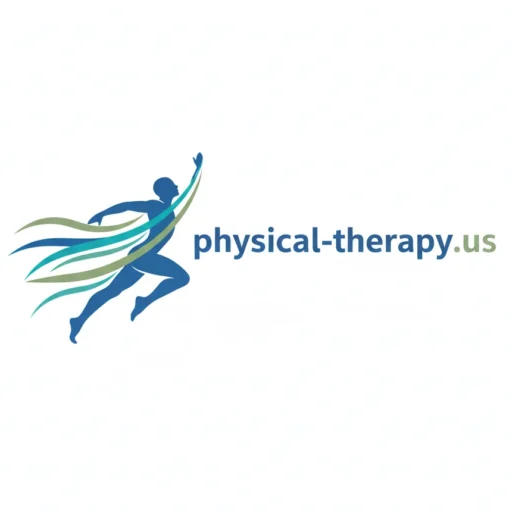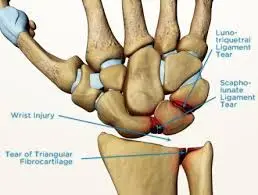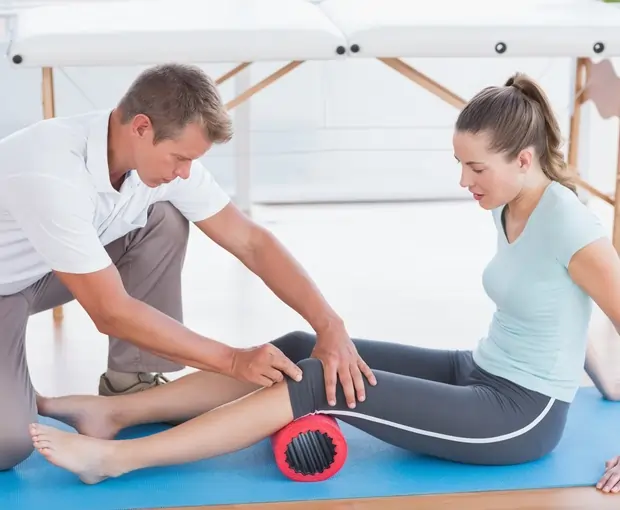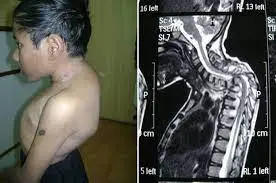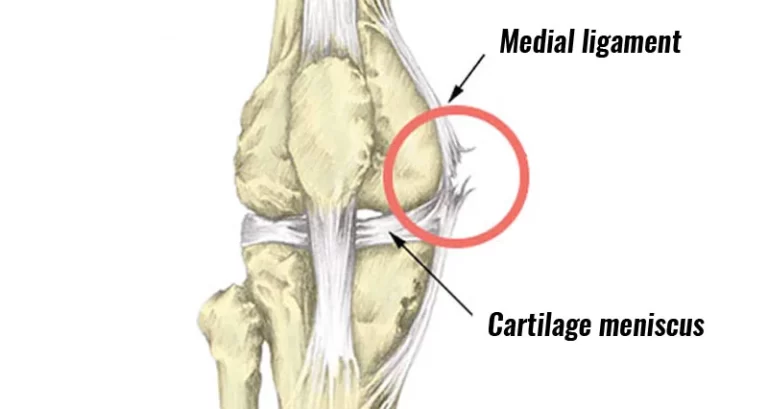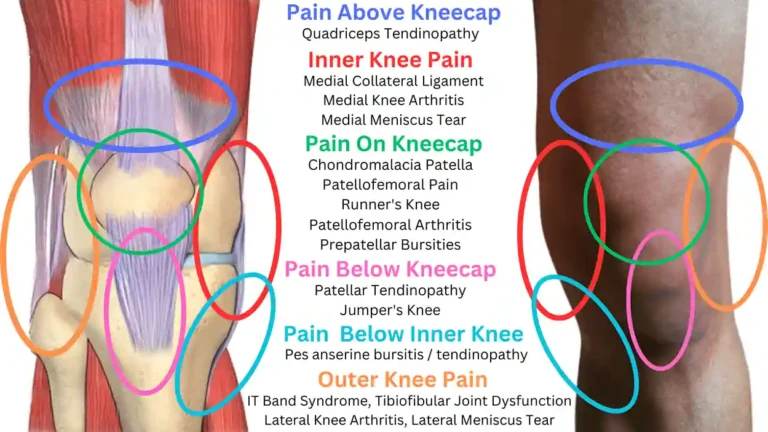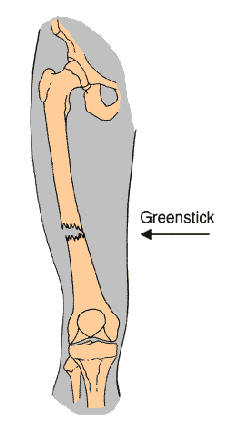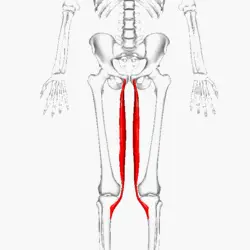Scapholunate Ligament Injury
What is a Scapholunate Ligament Injury?
A scapholunate ligament injury involves damage to the ligament connecting the scaphoid and lunate bones in the wrist. This ligament plays a key role in stabilizing the carpal bones and maintaining proper wrist mechanics.
Injury typically results from a fall on an outstretched hand or repetitive strain, leading to pain, swelling, and instability in the wrist. Early diagnosis and treatment are essential to prevent long-term complications such as arthritis or chronic wrist dysfunction.
Two bones are joined by a thick band of tissue called a ligament. The wrist is made up of several ligaments. The scapholunate ligament is one of the most often torn ligaments in a sprained wrist. This ligament lies between the lunate and scaphoid bones at the center of the wrist. It is a crucial structure for full and painless wrist movement. The scapholunate ligament can be injured in a variety of ways, from straining to tearing. Any injury has the potential to make the wrist uncomfortable and unstable.
Similar to other ligament sprains, the extent of the sprain can vary from a few fibers being torn to the SLL rupturing entirely. Carpal instability will result from this ligament rupturing or tearing. The most common wrist carpal instability is called scapholunate dissociation, which is the result of the scaphoid and lunate bones no longer aligning normally.
Scapholunate dissociation is linked to around 13.4% of distal radius fractures. Scapholunate Advanced Collapse (SLAC), a degenerative kind of wrist osteoarthritis, will eventually result from untreated SL instability.
Causes of Scapholunate Ligament Injury:
When the wrist is under a lot of stress, the scapholunate ligament typically tears. A fall onto the hand is a frequent cause. Usually, when the wrist is bent backward or into an odd position, the ligament is damaged.
Over time, the ligament may occasionally extend out. This may be the result of aging-related loosening or recurrent stresses. The ligament may also gradually deteriorate as a result of chronic inflammation. Chronic gout frequently damages this ligament.
Symptoms of Scapholunate Ligament Injury:
A scapholunate ligament injury frequently causes swelling and pain in the wrist, especially when moving in specific ways. The following symptoms could also be present:
- Wrist pain on both the dorsal and radial sides,
- included an increased loading,
- clicking or clunking sensation,
- weakness or instability in the wrist.
- Pain when bending the wrist backward
- Limited range of motion
- Bruising
- Popping or grinding.
A scapholunate ligament injury may cause pain and swelling immediately following the injury. It might continue and get worse over time. However, for other people, the issue won’t become apparent until years after the initial damage.
Diagnosis
It can be challenging to diagnose scapholunate ligament damage. Your wrist will be examined by your physician to determine its location of pain and to assess its range of motion. The injured and uninjured wrists may be compared by your surgeon.
History and Physical Examination:
Following a wrist injury, patients may experience dorsal radial wrist pain and weakness when loading the extended wrist. Their range of motion (ROM) and grip strength may be restricted by associated pain, which could impact various daily activities such as using a screwdriver, lifting heavy things, or grocery shopping. As a result, many patients might need to modify their lifestyles.
To better comprehend your wrist pain, X-rays are frequently utilized. Your wrist’s bones will be visible on an X-ray, even while ligaments are not. When you have a torn or injured scapholunate ligament, the wrist’s bone alignment and spacing also alter. The scaphoid and lunate are often held together by this ligament. The scaphoid and lunate separate and a gap appears when it is wounded. In certain cases, an MRI is required to confirm the diagnosis.
The extent of ligament damage can be seen by your surgeon using MRI. To detect a torn ligament, a radiologist may occasionally inject dye into the joint before the MRI. We call this an MR arthrogram. Additionally, some surgeons will suggest an arthroscopy. With wrist arthroscopy, the surgeon can see within the wrist joint using a tiny camera. This allows them to assess the wrist ligaments directly.
Special test:
Watson Test/Scaphoid Shift Test
A clinical test called the Watson Test sometimes referred to as the Scaphoid Shift Test, is performed to evaluate the wrist’s scapholunate ligament’s integrity. The examiner moves the patient’s wrist from ulnar to radial deviation while applying pressure to the scaphoid tubercle. A painful “clunk” or shift of the scaphoid, which suggests scapholunate ligament injury or instability, indicates a positive test. Scapholunate dissociation is a prevalent cause of persistent wrist pain and dysfunction, and this test aids in its early diagnosis.
Treatment of Scapholunate Ligament Injury:
The severity of an SLL injury determines how it is treated. There is currently no gold standard that can be established due to a lack of proof. For less severe SLL injuries (dynamic phase), conservative measures now include activity modification, NSAIDs for pain management, and a period of immobilization with a cast or splint.
Since arthroscopic debridement has been successful in lowering pain in individuals with partial tears who do not exhibit clinical signs of instability, these patients may also benefit from treatment. To hold the scaphoid and lunate bones in place while the ligament heals, surgical intervention such as pins and wires may be necessary for more severe SLL injuries, such as complete tears.
A damaged ligament in the scapula cannot heal by itself. Over time, a torn ligament usually results in arthritis if treatment is not received. This is due to the wrist’s bones no longer being retained in their natural position. Reducing pain and preventing arthritis are the two main objectives of treatment. Your alternatives for therapy will be discussed by your hand surgeon. The extent of your injury and the amount of time since it occurred will determine your available therapy options.
Pain management will be the primary objective of treatment if you recently had scapholunate ligament damage. This can entail resting the wrist, reducing activity, and donning a cast or splint. Feeling better could take six weeks or longer. After wearing a cast or splint, hand rehabilitation may be beneficial if the wrist becomes stiff. Anti-inflammatory drugs and cortisone shots (steroid injections) can reduce pain, but they cannot realign the wrist bones.
Surgery to rebuild or repair the ligament and help align the wrist bones may be considered if this non-operative treatment proves ineffective. An open surgery or an arthroscopy can be used for this. Wrist stiffness may result during ligament reconstruction or repair, but the wrist will be more stable. Generally speaking, a more stable wrist hurts less.
Other options are available when the injury has become more chronic; in chronic injuries, it is often too late to prevent arthritis or change the alignment of the wrist bones; in these cases, the goal is to control pain and try to preserve some function; sometimes, cutting the nerves to the inside of the wrist (wrist denervation) can help with pain; and there are many types of surgeries to help improve wrist function after arthritis develops, including partial wrist fusion, which involves biologically linking two bones together to prevent them from moving to reduce pain.
Physical Therapy Treatment of Scapholunate Ligament Injury:
For the recovery from scapholunate ligament injuries, physical therapy is essential. To promote healing, restore function, and lower the chance of long-term problems, a qualified physical therapist will evaluate the extent of the injury and create a customized treatment plan.
- Pain Management: Managing pain and lowering inflammation is one of the main objectives of physical therapy. Methods including manual treatment, ultrasound, and ice therapy can help reduce pain and accelerate recovery.
- Restoring Range of Motion: After a scapula injury, stiffness and restricted range of motion are typical. Gentle stretching techniques are used by physical therapists to improve wrist flexibility and return it to its natural movement patterns.
- Exercises for Strengthening: To stabilize the wrist joint, it is essential to strengthen the muscles surrounding it. To increase the wrist muscles’ strength and endurance and keep the joint steady while the ligament is repaired, physical therapists will lead you through targeted exercises.
- Joint Mobilization: To enhance wrist joint function and lower the risk of stiffness and long-term joint injury, gentle joint mobilization procedures can be employed.
- Education and Activity Modification: To prevent putting undue strain on the injured wrist, physical therapists will teach you the value of changing your everyday routine. Teaching appropriate hand placement, and ergonomics, and, if required, proposing assistive technology are all included in this.
- Progressive Rehabilitation: A physical therapist will gradually raise the intensity of exercises as the injury heals, progressing from basic range-of-motion drills to more complex strengthening and functional exercises, and ultimately assisting the patient in returning to their sport or daily activities.
Prevention of Scapholunate Ligament Injury:
Maintaining strong and flexible wrist muscles through consistent training and good ergonomics is essential to preventing a scapholunate ligament injury, particularly during sports or other activities that put a strain on the wrist. The risk of trauma can be decreased by wearing protective equipment, such as wrist guards when engaging in high-risk activities like skating or contact sports.
To prevent putting too much strain on the wrist joint, it’s also critical to use the right techniques while lifting, pushing, or bearing weight on the hands. In addition to minimizing repetitive strain, early treatment of wrist pain or instability can aid in preventing ligament damage and preserving wrist health over the long term.
Prognosis:
The severity and promptness of diagnosis and treatment have a significant impact on the prognosis of a scapholunate ligament injury. Conservative treatment for mild sprains or partial tears, such as immobilization and physical therapy, frequently results in a full recovery. However, if treatment is not received, complete tears or chronic injuries may lead to increasing arthritis, pain, decreased grip strength, and ongoing wrist instability.
While delayed therapy may restrict functional recovery, early surgical intervention in extreme cases can enhance long-term prognosis. In order to maximize wrist function and avoid long-term problems, regular follow-up and therapy are essential.
Complications of Scapholunate Ligament Injury:
A scapholunate ligament injury can cause chronic wrist instability, ongoing pain, and diminished grip strength if it is not treated or is not adequately managed. Scapholunate advanced collapse (SLAC wrist), a kind of degenerative arthritis marked by joint degradation and restricted wrist motion, may develop as a result over time.
Additional issues include weakness while moving the hands, clicking or catching sensations in the wrist, and trouble carrying out daily tasks. Surgery may be necessary in severe or chronic situations in order to relieve pain and restore function.
Conclusion:
The function and quality of life of the wrist can be significantly affected by a scapholunate ligament injury. However, the majority of people can either totally recover or effectively manage their symptoms with the assistance of a qualified physical therapist.
A good recovery depends on early intervention, specialized therapy, and appropriate management techniques to guarantee that the wrist regains its full strength and function without any long-term issues. For the best recovery, it is imperative that you consult a physical therapist if you suspect a scapholunate ligament injury.
FAQs
How can a scapholunate ligament injury be diagnosed?
The examiner performs the test by using one hand to stabilize the scaphoid and the other to move the wrist from ulnar to radial deviation.
A positive test means that the patient will feel pain and the examiner should feel a noticeable “clunk”.
How is a scapholunate ligament repaired?
It may be possible to surgically repair a recently torn ligament, usually using stitches secured to the bones with a tiny, permanent metal anchor. For weeks, a splint or cast must be worn, and temporary internal wires hold the wrist bones together while the restoration heals.
Where does a scapholunate ligament injury cause pain?
Particularly when performing wrist-loading exercises like push-ups, the athlete may experience pain on the middle or thumb side of the wrist. Additionally, there could be popping, swelling, snapping, or weakening in the grip.
How long does it take to heal from a scapholunate ligament tear?
Recovery from a scapholunate ligament tear can take anywhere from four to six months for partial tears and up to a year for full tears or reconstructions, depending on the severity and course of therapy.
How is an injury to the scapula ligament exercised?
Stretches for the Passive Wrist
Gently bend the involved wrist downward with the uninvolved hand. About 15 seconds should be spent holding a comfortable stretch. Three to four times a day, repeat 8 to 10. Gently bend the involved wrist toward the ceiling with the uninvolved hand.
What is the duration of recovery following wrist ligament surgery?
Depending on the type of surgery and the extent of the injury, recovery after wrist ligament surgery can take anywhere from 4 to 12 weeks or even up to a year. Most patients are ready to resume mild activities about 6 weeks after the procedure.
What consequences may a scapholunate ligament tear have in the long run?
Pain and stiffness are its initial symptoms, and if addressed, it can result in degenerative arthritis and carpal instability, which will impair function and cause disability.
How much time does it take for a scapula to heal?
To secure the bones in place, pins are placed into an incision made on the back of the wrist. While sutures anchored to the bone are utilized to repair the scapholunate ligament, an intraoperative x-ray is performed to verify alignment. It takes around three months for the scapholunate ligament to heal.
Does my wrist’s torn ligament require surgery?
In situations where the wrist ligament is totally injured, surgery known as wrist ligament reconstruction may be necessary. If ligament damage is discovered six months or longer after the initial accident, the ligament will typically need to be rebuilt.
Which brace is best for a tear in the scapholunate ligament?
Custom-fit or custom-fabricated wrist orthoses are suitable options for treatment. The Fix Comfort Wrist Brace is one of the prefabricated wrist orthoses that is available for moderate support. The 3pp Wrist Wrap NP provides effective wrist range of motion and support for post-operative or return to work splinting.
How often does scapholunate surgery go well?
Only if your problems were serious enough to warrant additional surgery would this be taken into consideration. A scapholunate reconstruction may fail completely or partially in up to one-third of patients, though the failure rate varies.
Does a scapholunate ligament injury require surgery?
Anti-inflammatory drugs and cortisone shots (steroid injections) can reduce pain, but they cannot realign the wrist bones. Surgery to rebuild or repair the ligament and help align the wrist bones may be considered if this non-operative treatment proves unsuccessful.
How can a scapholunate ligament injury be detected?
Two popular tests for evaluating scapholunate ligament instability are as follows: Scaphoid Shift Test by Watson: This exam determines whether the scaphoid and lunate bones are unstable. Pressure is given on the scaphoid tubercle in a volar-to-dorsal manner while the patient’s wrist is kept in ulnar deviation.
How severe is a tear in the scapholunate ligament?
With scapholunate ligament injuries, getting the right diagnosis is crucial since a delayed or incorrect diagnosis can lead to persistent wrist pain and the inability to bear weight through the wrist. Osteoarthritis can also be caused by persistent trauma to the scapula.
How long does it take for an injury to the scapula to heal?
Sprains are one type of scapholunate ligament injury, in which case the ligament remains intact. Other than early rest in a splint and analgesic medicine, these injuries don’t require any special care. Although a full recovery is typically anticipated, the symptoms may not go away for about 18 months.
References
- Lazzaro, D. (2025, March 4). Scapholunate Ligament Injuries: Physiotherapy Guide – Brisbane Physiotherapy & Podiatry. Brisbane Physiotherapy & Podiatry. https://www.brisbanephysiotherapy.com/news/scapholunate-ligament-injury-physiotherapy
- Wahed, K., Deore, S., Bhan, K., Vinay, S., Jayasinghe, G., Dutta, A., & Singh, B. (2020). Management of chronic scapholunate ligament injury. Journal of Clinical Orthopaedics and Trauma, 11(4), 529–536. https://doi.org/10.1016/j.jcot.2020.05.022
- SportsMD. (2024, August 12). Scapholunate Ligament Tear | Symptoms, treatment, surgery | SportsMD. https://www.sportsmd.com/sports-injuries/wrist-hand-injuries/scapholunate-ligament-tear/
